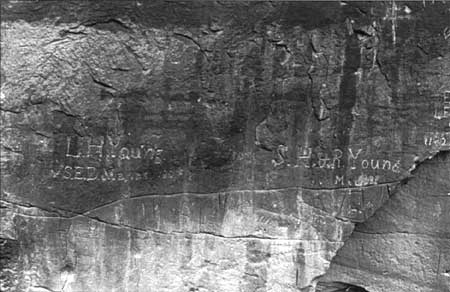|
Capitol Reef
Cultural Landscape Report |

|
ANALYSIS AND EVALUATION (continued)
ARCHEOLOGICAL RESOURCES
Prehistoric Resources
Twenty-four of the 38 archeological sites in the Fruita area include Formative period (agricultural/horticultural lifeway) components. These are considered to be Fremont because Fruita is the type locale for the Fremont culture, dating A.D. 300 - A.D. 1275. These remains represent the earliest farming activities in the area, although archeological evidence indicates habitation of the entire region from at least 8,500 years ago by Desert Archaic peoples. Six sites in Fruita include Archaic components, 2 include Paiute components that postdate the Fremont inhabitants, 11 are of unknown prehistoric origin, and the remainder are Fremont. These sites include abundant pictograph and petroglyph panels, circular, low structures in open habitations, rock shelters, storage sites, and lithic scatters.
The most important archeological sites in Fruita include a large rock shelter near the Krueger Orchard and a smaller shelter overlooking the Fremont River on the south side of Johnson Mesa. Other nearby sites include storage cists, granaries, and pit structures probably used for habitation. The sandstone cliffs that define Fruita contain 21 spectacular rock art panels diagnostic of Fremont style art, including large, anthropomorphic and shield figures. Prehistoric irrigation ditches were reported by the earliest explorers in the area, although direct evidence of valley bottom sites today is gone due to later cultivation by farmers. Because of the intense agricultural use of the valley floors, most existing archeological sites are located on the periphery of the settlement, on talus slopes and terraces above the fertile land.
Historic Sites and Structures
In addition to prehistoric archeological sites, several potentially significant historic archeological sites have been identified in the district. All of the sites and structures are associated with the historic period of significance, which dates from 1895 to 1946.
Fremont River Still Site
The still site is located approximately. 1 mile east from the confluence of Sulphur Creek and the Fremont River. It is the last visible remains of what tradition indicates was one of several such bootlegging operations in the area. The site includes the remnants of a shelter and parts of a cast iron stove.
Mulford Corrals
Remnant rock walls are located at the south end of the Mulford Orchard, where Mulford historically had his livestock corrals. Documentation suggests that the remaining rock walls comprised the structural base of the corrals, and that there was a hay rack constructed above this structure.

| |
| Remnants of the Mulford corrals, 1993. | |
Miscellaneous Rock Walls
A small section of dry-laid, terraced stone walls occur just east of the "mail tree." No documentation has been found to indicate when and by whom these walls were constructed, but they appear to be historic. They are located on the property last owned by "Doc" Inglesby, who purchased the land from William Chesnut in 1936 and resided in Fruita until 1959.
Inscription Rocks
Two large boulders in the district have inscriptions from the early Mormon settlement period. Both are located near the Holt Farm.

| |
| Inscription rock, above the Holt Farm complex, 1993. | |
Home Sites
A few former home sites have scattered remnant materials such as traces of building foundations and roads, ornamental plant materials, and abandoned irrigation ditches. While none of these sites have structural integrity, they may have value for interpretive programs. The historic home sites of Fruita have not been evaluated for their eligibility under National Register Criterion D.

| |
| Remnant irrigation works along the Fremont River, 1993. | |
Remnant Irrigation Works
A number of structural remnants associated with early irrigation works, including elevated wooden flumes, ditches, pipes, and gates, remain along the Fremont River. Individually these features can be seen as artifacts, but take on additional value when interpreted as the composite elements of a system.
| <<< Previous | <<< Contents >>> | Next >>> |
http://www.nps.gov/care/clr/clr4h.htm
Last Updated: 01-Apr-2003